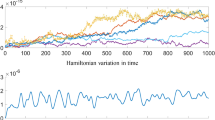Abstract
We consider numerical integrators of ODEs on homogeneous spaces (spheres, affine spaces, hyperbolic spaces). Homogeneous spaces are equipped with a built-in symmetry. A numerical integrator respects this symmetry if it is equivariant. One obtains homogeneous space integrators by combining a Lie group integrator with an isotropy choice. We show that equivariant isotropy choices combined with equivariant Lie group integrators produce equivariant homogeneous space integrators. Moreover, we show that the RKMK, Crouch–Grossman, or commutator-free methods are equivariant. To show this, we give a novel description of Lie group integrators in terms of stage trees and motion maps, which unifies the known Lie group integrators. We then proceed to study the equivariant isotropy maps of order zero, which we call connections, and show that they can be identified with reductive structures and invariant principal connections. We give concrete formulas for connections in standard homogeneous spaces of interest, such as Stiefel, Grassmannian, isospectral, and polar decomposition manifolds. Finally, we show that the space of matrices of fixed rank possesses no connection.




Similar content being viewed by others
References
R. Abraham, J. E. Marsden, and T. Ratiu. Manifolds, Tensor Analysis, and Applications, volume 75 of Applied Mathematical Sciences. Springer-Verlag, New York, second edition, 1988. ISBN 0-387-96790-7.
R.E. Beck. Connections on semisimple Lie groups. Trans. Am. Math. Soc., 164: 453–460, 1972. doi:10.2307/1995989.
M. P. Calvo, A. Iserles, and A. Zanna. Numerical solution of isospectral flows. Math. Comput., 66 (220): 1461–1486, 1997. doi:10.1090/S0025-5718-97-00902-2.
É. Cartan. La structure des groupes de transformations continus et la théorie du trièdre mobile. Bull. Sci. Math., II. Sér., 34: 250–283, 1910.
É. Cartan. Sur une classe remarquable d’espaces de Riemann. I. Bull. Soc. Math. Fr., 54: 214–264, 1926.
É. Cartan and J. Schouten. On the geometry of the group-manifold of simple and semi-simple groups. Nerl. Akad. Wensch. Proc. Ser. A, 29: 803–815, 1926.
E. Celledoni and B. Owren. On the implementation of Lie group methods on the Stiefel manifold. Numer. Algorithms, 32 (2-4): 163–183, 2003. doi:10.1023/A:1024079724094.
E. Celledoni, A. Marthinsen, and B. Owren. Commutator-free Lie Group Methods. Future Gener. Comput. Syst., 19 (3): 341–352, April 2003. doi:10.1016/S0167-739X(02)00161-9.
A. Edelman, T. A. Arias, and S. T. Smith. The geometry of algorithms with orthogonality constraints. SIAM J. Matrix Anal. Appl., 20 (2): 303–353, 1998. doi:10.1137/S0895479895290954.
J. Gallier. Notes on Differential Geometry and Lie Groups. Lecture notes, 2014. http://www.cis.upenn.edu/jean/gbooks/manif.html.
E. Hairer, C. Lubich, and G. Wanner. Geometric numerical integration: structure-preserving algorithms for ordinary differential equations. Springer series in computational mathematics. Springer, 2006. ISBN 9783540306634.
S. Helgason. Differential Geometry and Symmetric Spaces. Pure and applied mathematics. American Mathematical Society, 1962. ISBN 9780821873175.
A. Iserles, H. Z. Munthe-Kaas, S. P. Nørsett, and A. Zanna. Lie-group methods. In Acta Numerica. Vol. 9, pages 215–365. Cambridge: Cambridge University Press, 2000.
A. Kirillov. An introduction to Lie groups and Lie algebras. Cambridge: Cambridge University Press, 2008. ISBN 978-0-521-88969-8/hbk.
S. Kobayashi and K. Nomizu. Foundations of differential geometry. Vol. II. Wiley, 1969. ISBN 9780470496480.
D. Lewis and P. J. Olver. Geometric integration algorithms on homogeneous manifolds. Found. Comput. Math., 2 (4): 363–392, 2002. doi:10.1007/s102080010028.
R. I. McLachlan, K. Modin, H. Z. Munthe-Kaas, and O. Verdier. B-series methods are exactly the affine equivariant methods. Accepted in Numerische Matematik, 2015. arXiv:1409.1019.
RI McLachlan and GR Quispel. Six lectures on the geometric integration of odes. In Foundations of Computational Mathematics, London Mathematical Society Lecture Note Series, pages 155–210. Cambridge University Press, 2001. ISBN 9780521003490.
B. Minchev. Exponential Integrators for Semilinear Problems. PhD thesis, University of Bergen, 2005. http://www.ii.uib.no/borko/pub/PhD_thesis.pdf.
H. Munthe-Kaas. High order Runge-Kutta methods on manifolds. Appl. Numer. Math., 29 (1): 115–127, 1999. doi:10.1016/S0168-9274(98)00030-0.
H. Z. Munthe-Kaas and O. Verdier. Aromatic Butcher Series. Foundations of Computational Mathematics, 2015. doi:10.1007/s10208-015-9245-0.
K. Nomizu. Invariant affine connections on homogeneous spaces. Am. J. Math., 76: 33–65, 1954. doi:10.2307/2372398.
X. Pennec, P. Fillard, and N. Ayache. A Riemannian framework for tensor computing. International Journal of Computer Vision, 66 (1): 41–66, 2006.
P. Piccione and D. V. Tausk. A student’s guide to symplectic spaces, Grassmannians and Maslov index. Rio de Janeiro: Instituto Nacional de Matemática Pura e Aplicada (IMPA), 2008. ISBN 978-85-244-0283-8.
R.W. Sharpe. Differential geometry: Cartan’s generalization of Klein’s Erlangen program. Graduate texts in mathematics. Springer, 1997. ISBN 9780387947327.
S. Sternberg. Lectures on differential geometry. Prentice-Hall Mathematics Series. Englewood Cliffs: Prentice-Hall, Inc. xi, 390 pp. (1964), 1964.
O. Verdier. Integrators on homogeneous spaces: local isotropy maps. in preparation, 2015.
A. Zanna, K. Engø, and H. Z. Munthe-Kaas. Adjoint and selfadjoint Lie-group methods. BIT, 41 (2): 395–421, 2001. doi:10.1023/A:1021950708869.
Acknowledgments
This research was supported by the Spade Ace Project and by the J. C. Kempe memorial fund.
Author information
Authors and Affiliations
Corresponding author
Additional information
Communicated by Ernst Hairer.
Rights and permissions
About this article
Cite this article
Munthe-Kaas, H., Verdier, O. Integrators on Homogeneous Spaces: Isotropy Choice and Connections. Found Comput Math 16, 899–939 (2016). https://doi.org/10.1007/s10208-015-9267-7
Received:
Revised:
Accepted:
Published:
Issue Date:
DOI: https://doi.org/10.1007/s10208-015-9267-7
Keywords
- Homogeneous spaces
- Symmetric spaces
- Lie group integrators
- Connection
- Runge–Kutta
- Skeleton
- Stiefel manifold
- Lax pair
- Grassmannian
- Projective space
- Polar decomposition
- Constant rank matrices




